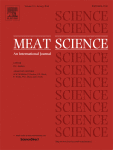Ver ítem
- xmlui.general.dspace_homeCentros e Institutos de InvestigaciónCIA. Centro de Investigaciones de AgroindustriaInstituto de Tecnología de AlimentosArtículos científicosxmlui.ArtifactBrowser.ItemViewer.trail
- Inicio
- Centros e Institutos de Investigación
- CIA. Centro de Investigaciones de Agroindustria
- Instituto de Tecnología de Alimentos
- Artículos científicos
- Ver ítem
Warmed-over flavour analysis in low temperature–long time processed meat by an “electronic nose”
Resumen
The ability of an electronic nose, comprising 32 conducting polymer sensors, to identify and classify warmed-over flavour (WOF) aroma in bovine semitendinosus muscle, processed by vacuum cook-in-bag/tray technology (VCT) and storage under refrigerated conditions, was evaluated. The VCT process employed low temperature–long time (50°C–390 min) thermal treatments. Multivariate analysis showed that VCT processed beef aroma profiles were sorted into two
[ver mas...]
The ability of an electronic nose, comprising 32 conducting polymer sensors, to identify and classify warmed-over flavour (WOF) aroma in bovine semitendinosus muscle, processed by vacuum cook-in-bag/tray technology (VCT) and storage under refrigerated conditions, was evaluated. The VCT process employed low temperature–long time (50°C–390 min) thermal treatments. Multivariate analysis showed that VCT processed beef aroma profiles were sorted into two groups, one included samples stored for up to 20 days and the other included samples with 34 to 45 days of storage. WOF odour standard samples were recognised to have similar aroma as samples of the second group. Lipid oxidation results, measured by thiobarbituric acid reactive substances, showed an increment in oxidation level for samples stored for 34 days or more (P<0.05). This study shows that electronic nose technology can be applied to WOF odour identification and classification in VCT beef meat, complementing chemical and sensory techniques used in this field.
[Cerrar]

Fuente
Meat Science 56 (3) : 221-228 (November 2000)
Fecha
2000-04-18
Editorial
Elsevier
ISSN
0309-1740
Formato
pdf
Tipo de documento
artículo
Palabras Claves
Derechos de acceso
Restringido
 Excepto donde se diga explicitamente, este item se publica bajo la siguiente descripción: Creative Commons Attribution-NonCommercial-ShareAlike 2.5 Unported (CC BY-NC-SA 2.5)
Excepto donde se diga explicitamente, este item se publica bajo la siguiente descripción: Creative Commons Attribution-NonCommercial-ShareAlike 2.5 Unported (CC BY-NC-SA 2.5)

